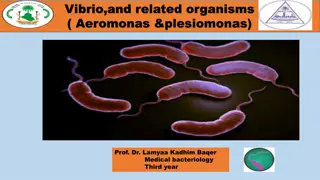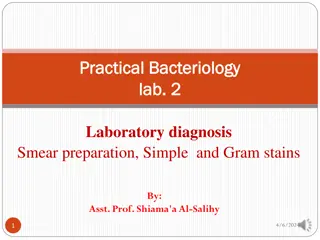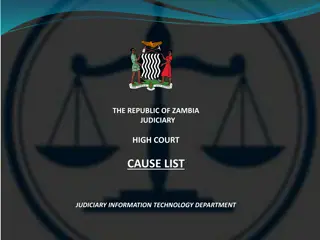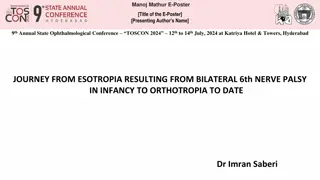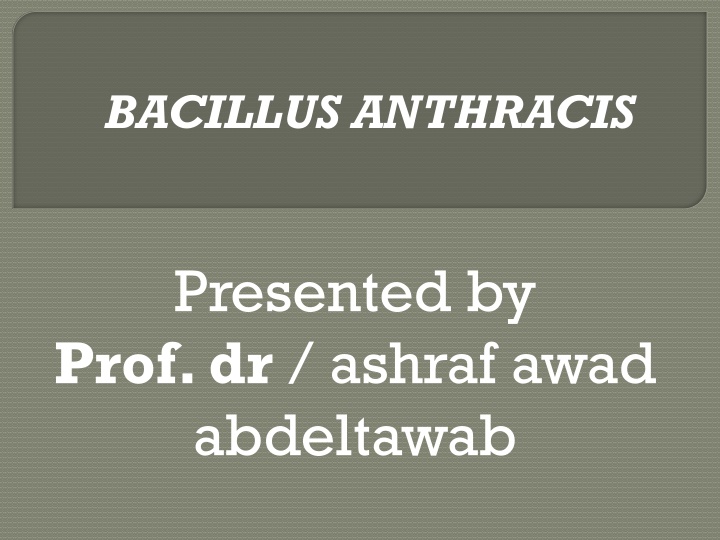
Learn about Bacillus Anthracis Morphology, Characteristics, and Distribution
Discover the detailed morphology, cultural characteristics, and distribution of Bacillus anthracis, a gram-positive, spore-forming bacterium found in soil and decaying vegetation. Explore its unique features, including capsule formation, growth preferences, and biochemical properties.
Download Presentation

Please find below an Image/Link to download the presentation.
The content on the website is provided AS IS for your information and personal use only. It may not be sold, licensed, or shared on other websites without obtaining consent from the author. If you encounter any issues during the download, it is possible that the publisher has removed the file from their server.
You are allowed to download the files provided on this website for personal or commercial use, subject to the condition that they are used lawfully. All files are the property of their respective owners.
The content on the website is provided AS IS for your information and personal use only. It may not be sold, licensed, or shared on other websites without obtaining consent from the author.
E N D
Presentation Transcript
BACILLUS ANTHRACIS Presented by Prof. dr / ashraf awad abdeltawab
Distribution : They are found in the soil and on decaying vegetation where they are most active in bringing about the decomposition of organic substances .because of the resistance of the spores to high temperatures and desiccation .these organisms are among those which most frequently contaminate culture media in the laboratory as anthracoids.
Morphology and staining gram positive bacilli capsulated sporulated ( central spore)
Cultural characters: It is aerobic; grow well at 37 c and pH 7.8. On nutrient agar, surface colonies appear dull, opaque , grayish-white with an irregular border from which long strands of cells are seen in parallel arrangement the typical "medusa head" characteristic appearance
In broth, is turbid with a floccular growth on the surface which sinks to the bottom of the tube within 24 hours. Bacillus anthracis grows readily on blood agar In a gelatin stab culture, filaments of growth radiate from the line of puncture and give the appearance of inverted fire tree.
The organism losses its capsule when grown on artificial media unless the medium is incubated atmosphere of 10% co2. in an Contrary to the usual type of variation, rough (R) is normal and virulent whereas smooth (S) colonies are avirulant
Biochemical properties: Bacillus anthracis forms acid but not gas from glucose, sucrose, maltose, fructose and dextrin. Some strains produce slight acid in glycerol amd salicin . The organism not ferments lactose, galactose and mannitol.
Indol and H2S are negative while methylene blue is reduced and MR positive and VP negative. Litmus decolorized milk is and coagulated, slowly peptonized.
Resistance and viability: Spores are resistant and remain viable for many years in the soil. The organism is rapidly destroyed by decomposition in un opend carcasses after the third day. 10 % formalin at 40 c will kill anthrax spores in 15 minute.
Freshly prepared 5% sodium hydroxide is satisfactory agent for disinfecting contaminated by the spores of objects this organism
Antigenic structure and toxins: Bacillus anthracis has two antigenic substances (capsular antigen and somatic polysaccharides antigen).both antigens act specifically with precipitating sera. No antigenic groups have been reported for the organism. Bacillus anthracis produces two toxic substances when grown in acasamino acid medium without serum or other proteins.
One component called protective antigen and the other called filter factor, the protective antigen migrates in an invisible component intermediate between the gamma and beta globulins it is destroyed by heating at 57 c for 30 minute and by trypsin .
Pathogenicity : Bacillus anthracis is pathogenic for cattle, sheep, horses,mules,swine,dogs and cats. It causes septicemia in the first four species of animals. On P.M, anthrax is characterized by oedematous infilterations in the subcutaneous, haemorrhages in various parts of the body especially in the serous membranes, marked swelling of the spleen, which is dark red and soft, the blood is dark red, tarry and does not clot. Hemorrahages are often observed from the natural body openings.
Cutenous anthrax: Resulted from skin infection through scratches or other breaks in the skin. Regional lymph nodes are swollen and painful. Intestinal anthrax: Resulted from the eating of uncooked meat from an anthrax carcass and is extremely rare in civilized countries. Respiratory form: It is acquired through inhalation of the air when working with materials contaminated with bacillary spores.
Immunity: Two vaccines were used: Pasteur vaccine 1: attenuated by growing at 42 c for 12 day , it kills mice but not guinea pig or rabbits. Pasteur vaccine 2: attenuated for shorter time, about (5-7 days) so it kills mice and guinea pigs but not rabbits and sheep. By using pasteur vaccine 2 simultaneously with immune serum. By using spore vaccine which is attenuated to correspond to pasteur vaccine 2 and it is given intradermal. Serum therapy in anthrax has been demonstrated to be dependable.
Diagnosis of anthrax: In submitting material for anthrax diagnosis; great caution must be exercised, it is an unnecessary risk to autopsy carcass which has obviously died of anthrax, sending an ear packed in a tight suitable container is universal practice, also sending of blood smears, cotton swabs, and small vial of blood or tissues is preferable if sufficient caution is taken.
By direct microscopic smears from the infected materials blood film from ear vein stained with poly chrome methlyne blue and observing the definite capsule surrounding the bacilli. Cultivation on blood agar where no haemolysis is produced and the typical curly edge of the colonies is seen.
Subcutaeneous inoculation of suspected materials into guinea pigs in which death is usually produced in 48 hours. Gelatinous edema and hemorrhage are found at the inoculation site and numerous bacilli are seen in stained smears made from fluid in the area
By Ascolis test: It depends on the occurrence of specific precipitation in the serum of an immunized animal. Serum with known precipitating properties must be selected. An extract of the tissues is made in slightly acidified saline. The fluid is boiled for extraction, then filtrate through filter paper. 0.5ml of serum is placed in a narrow tube and the filtrate is carefully run onto the top. The development of white ring of precipitate at the junction of the two fluids denotes positive result
Characters B. anthracis B. anthracoids Motility Non motile Motile Capsule Present Abscent Shape and position of spore Oval, cenrta,not bluged Vary in shape without bluging Chain formation Growth in long chain Singly,diplo,short chain Growth in broth Cotton wool fluffy deposit Turbidity or pellicle Growth in galatin stab Inverted fir tree Fire tree absent Haemolysis Weak or no Strong ( ) Pathogenicity for - Mice. Die (24 hr.) Large dose are pathogenic. - G.P. Die (48 hr.) Non pathogenic. - Rabbit. Die (72 hr.) Non pathogenic.
Thank you


